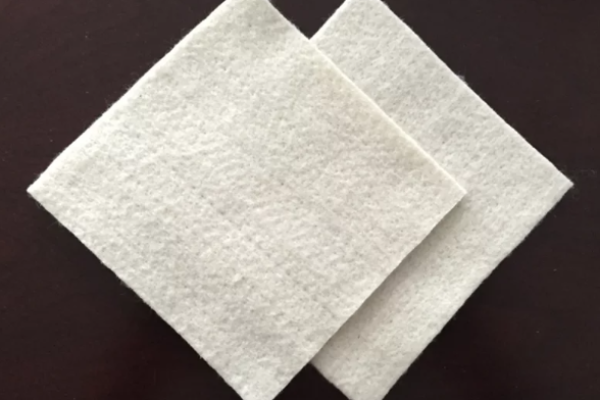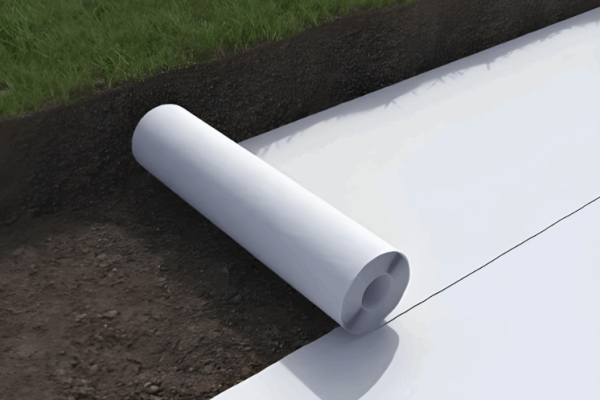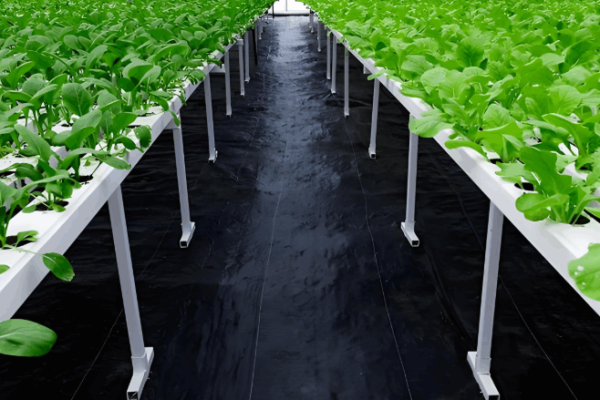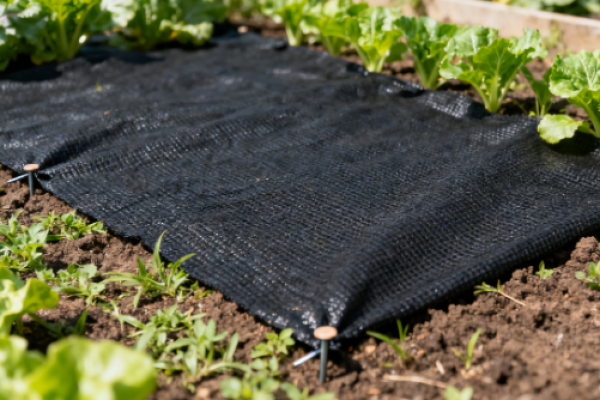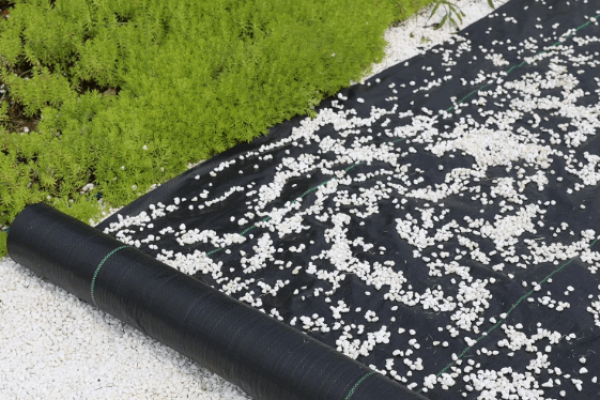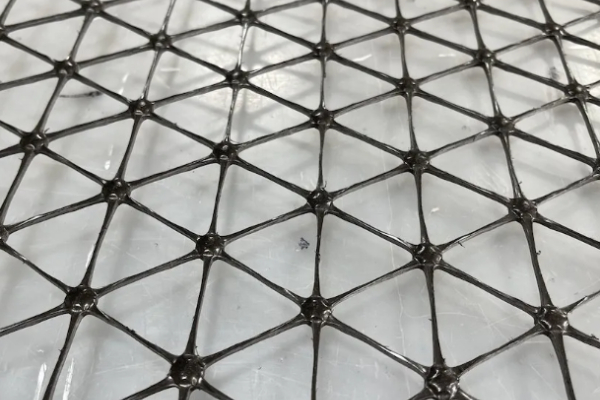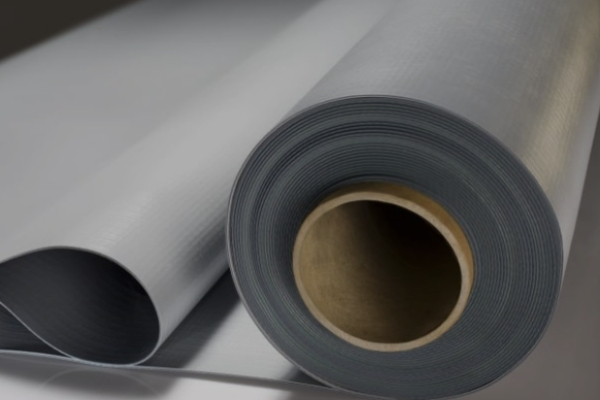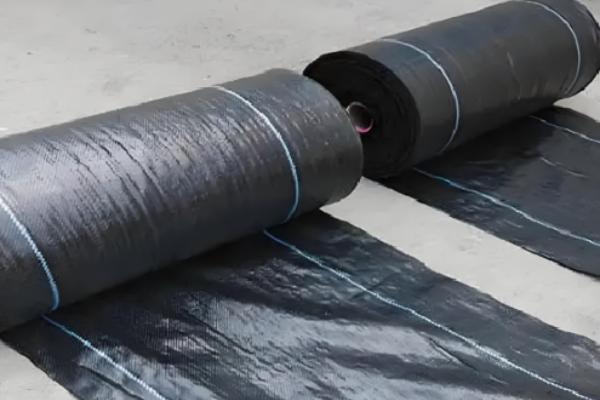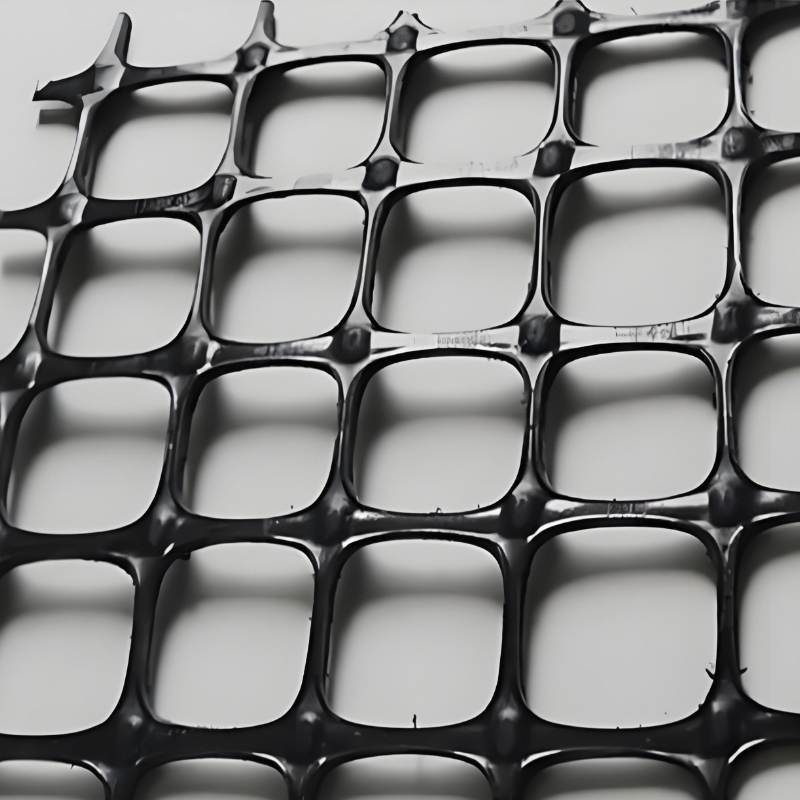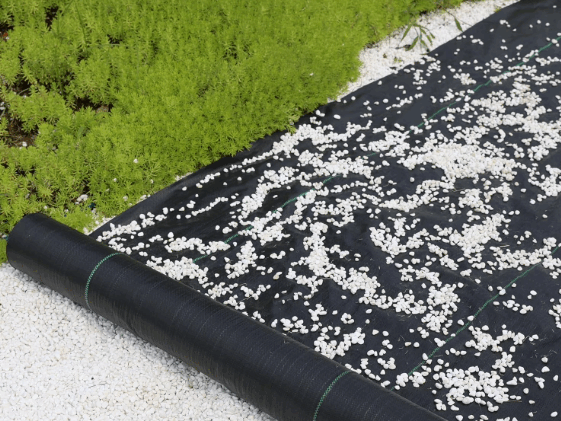- What is Driveway Geotextile Fabric?
- Main Types of Driveway Geotextile:Woven vs.Non-Woven
- Key Benefits of Using Geotextile for Your Driveway
- How to Correctly Use Geotextile in Driveway Construction?
- 2.Installation Steps:3 Key Steps,Don't Overlook Details
- 3.Requirements for Different Driveway Types:Targeted Installation for Durability
- How to Choose the Right Geotextile for Your Driveway?
- Driveway Geotextile Fabric FAQ
- Conclusion
Many homeowners face a series of frustrating problems 1-3 years after their driveway is built:localized subsidence after the rainy season causes noticeable bumps when driving over it;water pools are difficult to drain,and long-term saturation softens the base course,leading to surface damage.These issues can be effectively addressed by using geotextile fabric for driveways.
This article will break down the application logic of driveway geotextile from four perspectives:what it is,its core value,installation guidelines,and selection tips.It will help you avoid the common construction pitfall of”focusing only on surface materials while neglecting base protection,”ensuring every penny spent on building or renovating your driveway is a wise investment.
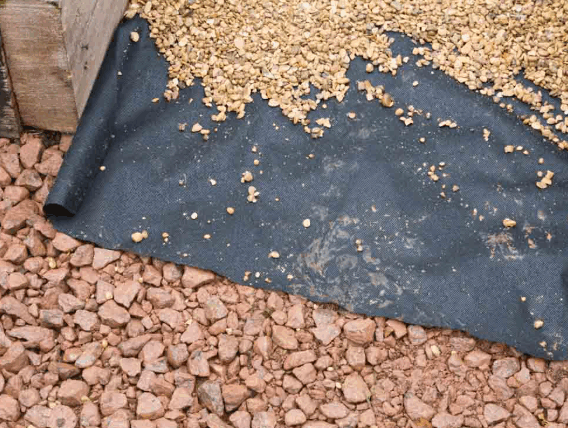
What is Driveway Geotextile Fabric?
Driveway geotextile fabric is not ordinary gardening weed barrier or liner.It is a permeable geosynthetic material manufactured through special processes using polypropylene(PP)or polyester(PET)as its core raw materials.It must meet three critical properties:
High Strength:Tensile strength≥10 kN/m in both machine and cross-machine directions,enabling it to withstand vehicle loads and subgrade soil tension without stretching or breaking.
High Permeability:Permeability coefficient≥1×10⁻³cm/s,allowing rainwater to quickly pass through the geotextile fabric into the ground or drainage system,preventing water accumulation.
Abrasion and UV Resistance:The surface is treated with anti-UV additives to resist sun and rain exposure.Whether exposed long-term or buried in the base,its service life can reach 5-10 years,and it resists damage from gravel and soil particles.
Main Types of Driveway Geotextile:Woven vs.Non-Woven
There are two primary types of geotextile commonly used for driveways,selection should be based on driveway material compatibility:
Woven Geotextile Fabric:Made from woven polypropylene tapes,it offers high strength and excellent tear resistance.It is suitable for base separation in gravel driveways and asphalt driveways–effectively preventing soil particles from migrating into the gravel layer,which avoids settlement caused by gravel and soil mixing.
Non-Woven Geotextile Fabric(Needle-Punched):Made from polyester fibers bonded through needle-punching,it offers higher permeability and superior filtration.It is more suitable for the base of concrete driveways–reducing direct contact between concrete and soil,thereby minimizing cracks caused by soil shrinkage and expansion.
Synergistic Effects with Other Driveway Materials:Not”Used Alone”but”Combined for Enhanced Performance”
Geotextile is not a standalone material;it works synergistically with primary materials like gravel,asphalt,and concrete:
With Gravel:Installed between the soil subgrade and the gravel layer,it separates soil from gravel,preventing gravel from”sinking”into the soil while allowing rainwater to drain through the gravel and geotextile,keeping the gravel layer dry.
With Asphalt:Placed between the asphalt layer and the base course,it enhances the bond between the asphalt and the base,reducing cracks caused by base deformation.It also blocks soil moisture from rising.
With Concrete:Placed beneath the concrete slab,it buffers the pressure from uneven soil settlement on the concrete,reducing cracks.It also filters rainwater,preventing soil particles from clogging concrete joints.
If you are purchasing geotextile fabric driveway, you can contact us
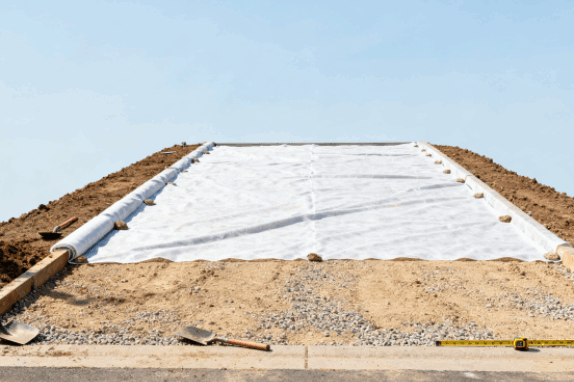
Key Benefits of Using Geotextile for Your Driveway
1.Enhanced Stability:Prevents Settlement and Deformation at the Source
The main cause of driveway settlement is the”mixing of subgrade soil with fill material.”For example,in a gravel driveway,soil particles gradually seep into the gaps between gravel,reducing the density of the gravel layer and causing localized depressions.Installing geotextile fabric acts like a”filter”separating soil from gravel(or asphalt/concrete),preventing soil particle migration and maintaining the structural stability of the fill layer,significantly reducing settlement risk even under long-term vehicle traffic.
2.Improved Drainage:Rapidly Channels Water Away,Reducing Structural Erosion
During the rainy season,if water pools on the driveway and cannot drain promptly,it saturates the subgrade soil,causing softening.In winter,frozen water expands and can crack the surface.The high permeability of geotextile accelerates water infiltration while filtering out impurities that could clog drainage paths–tests show water drains 3-5 times faster from driveways with geotextile,and subgrade soil moisture content can be reduced by over 40%.
3.Weed Suppression:Lowers Maintenance Costs,Keeps Driveway Neat
Weed roots are highly penetrative.If they grow through driveway cracks,they can widen them and damage the structure.Removal can also scratch the surface.The fibrous structure of geotextile fabric blocks weed roots from penetrating,suppressing growth at the source–while unlined driveways may require weed cleaning 3-4 times yearly,those with geotextile need it less than once a year,saving significant time and cost.
4.Extended Lifespan:Reduces Damage,Lowers Refurbishment Frequency
Industry data indicates the average lifespan of a standard driveway without geotextile is 3-5 years,whereas one with geotextile can last 8-10 years.This is because the fabric reduces erosion of the main structure by soil and water,lowering the probability of cracks,settlement,and damage–for instance,an unlined asphalt driveway may need patching within 3 years,while one with geotextile often requires no major repairs for 5 years.
5.Cost Savings:More Economical Long-Term
Although installing geotextile adds initial material cost(approximately¥5-15 per square meter),it saves money on long-term maintenance.For a 100 m²driveway:
Without Geotextile:Localized repairs needed at 3 years(~¥2000),full resurfacing at 5 years(~¥15,000),total 10-year cost~¥32,000.
With Geotextile:No repairs for 5 years,only localized resurfacing at 10 years(~¥8000),total 10-year cost~¥23,000(including geotextile cost),saving nearly¥10,000.
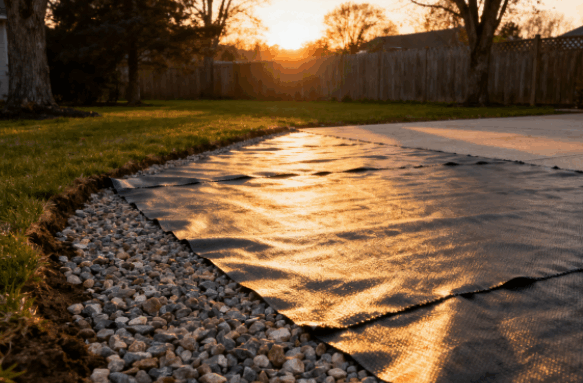
How to Correctly Use Geotextile in Driveway Construction?
1.Pre-Construction Preparation:Two Steps for Smoother Progress
(1)Site Clearing:Make the Base”Clean and Level”
Clear surface vegetation,rocks,roots,and debris.Level any mounds or fill depressions.
Perform initial compaction(using a small roller or manual tamper)to avoid later soil settlement wrinkling the geotextile.
If water is present,dig drainage ditches first.Wait until soil moisture content is below 20%(soil crumbles easily when squeezed)before construction.
(2)Material Calculation:Accurately Estimate Quantity Based on Size and Slope
Area:Standard rectangular driveways use length×width.Add 5-10%extra for corners/irregular shapes(for overlap and cutting waste).
Slope Adjustment:For slopes>5°,add 3%more material to account for stretching during installation,preventing insufficient coverage.
Spec Selection:Choose 300-400 g/m²woven geotextile for gravel or asphalt driveways;choose 200-300 g/m²non-woven geotextile for concrete driveways.
2.Installation Steps:3 Key Steps,Don’t Overlook Details
(1)Subgrade Preparation:Compaction is Key
Compact the cleared soil subgrade with a roller(small household type is fine)until compaction reaches over 90%(no significant depression when stepped on).
If soil is sandy or soft,first add a 5-10 cm layer of plain soil(clay without impurities)and compact it to enhance bearing capacity.
(2)Geotextile Installation:Correct Direction,Overlap,and Securing
Direction:Lay the roll along the driveway’s length(machine direction parallel to traffic direction)for maximum tensile strength resistance against vehicle loads.
Overlap Width:Overlap adjacent rolls by 8-12 cm.Secure overlaps with anchor pins or specialized geotextile adhesive to prevent water seepage.
Securing:Use plastic anchor pins(spaced 50-60 cm apart)along edges.Increase pin density(30-40 cm spacing)at corners and steep slopes to prevent shifting.
(3)Subsequent Steps:Install Primary Materials Promptly to Protect Geotextile
After laying the geotextile fabric,install gravel,asphalt,or concrete within 24 hours to minimize UV degradation,wind displacement,or damage from debris.
When placing gravel,proceed from one end,dropping gravel from less than 50 cm height to avoid impact damage.
For asphalt or concrete,control temperatures(asphalt≤180°C)and avoid direct contact of vibrators with the geotextile to prevent heat or mechanical damage.

3.Requirements for Different Driveway Types:Targeted Installation for Durability
(1)Gravel Driveways:Balance Permeability and Filtration
Use woven geotextile(300 g/m²)between soil subgrade and gravel.Gravel layer should be≥15 cm thick(laid and compacted in two 7-8 cm layers).
In high rainfall areas,consider shallow drainage trenches(15 cm wide,10 cm deep)beneath the geotextile for enhanced drainage.
(2)Asphalt Driveways:Ensure Bonding
Use non-woven geotextile(250 g/m²)between asphalt and gravel base.Spray a small amount of emulsified asphalt on the base before laying the fabric to enhance bonding.
Asphalt layer should be≥5 cm thick(3 cm base course+2 cm surface course,compacted from center to edges to avoid wrinkling the geotextile).
(3)Concrete Driveways:Reduce Cracking
Use non-woven geotextile(200 g/m²)between concrete and soil subgrade.Lightly sprinkle cement powder on the geotextile before pouring concrete to improve bonding.
After pouring,cover the concrete with curing compound or wet burlap(avoid direct sun)and cure for at least 7 days.
How to Choose the Right Geotextile for Your Driveway?
1.Key Parameters:3 Indicators Determine Quality
(1)Tensile Strength:Both Directions Must Meet Standards
Prioritize products with≥10 kN/m tensile strength in both directions(check quality reports).For heavy vehicles(SUVs,small trucks),choose≥15 kN/m.
Simple Test:Pull the edge of the fabric;high-quality product resists stretching and shows no significant permanent deformation.
(2)Permeability Coefficient:Ensure Unobstructed Drainage
Permeability coefficient must be≥1×10⁻³cm/s(stated in reports).Lower values can cause water pooling on top of the geotextile,leading to driveway积水(water accumulation).
Simple Check:Pour water on the laid fabric;good quality allows rapid penetration with minimal surface water.
(3)UV Resistance:Look for Anti-UV Treatment
Choose products labeled”UV stabilized”or”UV resistance grade≥3″.These resist becoming brittle and cracking when exposed outdoors for up to 5 years.
Avoid very light-colored(e.g.,pure white)products or those without UV resistance labeling,as they degrade quickly.

2.Avoid Common Mistakes:Steer Clear of These 3 Pitfalls
(1)Prioritizing Price Over Material Strength
Some sellers market cheap”gardening fabric”(¥2-3/m²)as driveway geotextile.Its tensile strength is often<5 kN/m,leading to failure within 1-2 years and higher repair costs.
Advice:Be cautious of geotextile fabric priced below¥5/m²;prioritize reputable products in the¥5-15/m²range.
(2)Confusing Gardening Fabric with Driveway-Specific Geotextile
Gardening fabric(for weed/root barrier)typically has low permeability and strength,unlike the high permeability and strength required for driveway applications.
Differentiation:Check the description.Driveway-specific geotextile will state”for roads,driveway base,”while gardening fabric says”for gardens,flower beds.”
(3)Ignoring the Impact of Environment on Specifications
High rainfall areas need high-permeability(≥1.5×10⁻³cm/s)non-woven geotextile.
Cold regions(winter≤-10°C)need frost-resistant geotextile(labeled”low-temperature resistance≥-20°C”),preferably polyester-based for better cold tolerance.
For slopes>10°,choose woven geotextile with tensile strength≥15 kN/m for better anti-slip performance.
Driveway Geotextile Fabric FAQ
It depends on the base condition.If the subsoil is soft,shows signs of settlement,or the gravel/asphalt is severely mixed with soil,remove the old layer and install new geotextile.If the base is sound with only surface damage(cracks,spalling),surface repair suffices without additional geotextile.
Load capacity depends on the entire base structure.With a 15 cm gravel base,standard 300 g/m²woven geotextile can handle passenger cars(1.5-2.5 tons)and SUVs(2.5-3.5 tons).For small trucks(5-8 tons),use≥400 g/m²woven geotextile and increase gravel base thickness to 20 cm.
Under normal use:Woven lasts 5-8 years;non-woven lasts 7-10 years.If buried(under asphalt/concrete),lifespan extends by 2-3 years.
Repairs:For small holes(<10 cm diameter),use a round patch of the same material(5 cm larger than hole)and specialized adhesive.For large damage(>10 cm),overlay with new geotextile(minimum 15 cm overlap)and re-secure.
Yes.Freeze-thaw cycles cause soil expansion and contraction,potentially damaging the fabric.Choose frost-resistant geotextile(“low-temperature resistance≥-20°C”,polyester is better than PP).Adding a 5 cm layer of graded gravel/sand beneath the geotextile can also reduce frost heave pressure.
Yes.For home driveways,large tools aren’t essential:Use shovels and rakes for clearing;a manual tamper(¥200-300)for compaction;a hammer for plastic anchor pins;a utility knife for cutting.Focus on correct overlap width and subgrade compaction.Following this guide,1-2 people can install geotextile for a 100 m²driveway in one day.
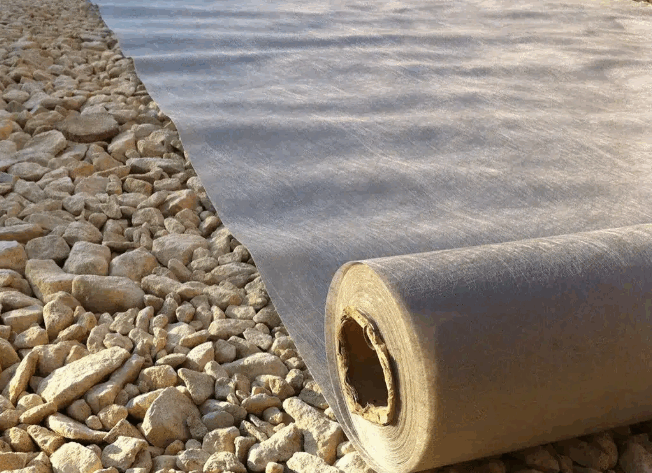
Conclusion
In driveway construction,geotextile fabric,though hidden in the base,is the”unseen critical component”–it doesn’t dictate appearance but fundamentally addresses core issues like settlement,cracking,water pooling,and weeds,extending lifespan and lowering maintenance costs.
For homeowners planning to build or renovate a driveway,rather than over-investing in surface materials(like asphalt or concrete),prioritize base protection:choose the right driveway geotextile fabric,install it correctly,and let it work synergistically with primary materials to create a durable,low-maintenance,and cost-effective quality driveway.
Final reminder:Installation isn’t entirely maintenance-free.Regularly inspect the surface(repair cracks promptly to prevent water damage to the geotextile)and clear drainage outlets to maximize the fabric’s protective role and ensure long-term stability.
References:
- Geosynthetics-Filament Woven Geotextile(GB/T 17640-2008):This Chinese standard specifies technical requirements,test methods,and quality assessment rules for filament woven geotextiles,providing the basis for parameters like tensile strength and permeability relevant for selecting woven geotextile for driveways.
- Technical Code for Application of Geosynthetics in Waterway Engineering(JTJ239-2005):Although superseded,its technical requirements regarding geotextile installation process,overlap width(8-12 cm),and subgrade treatment remain valuable references for driveway construction.Current best practices should align with the latest applicable road engineering geosynthetics standards.
If you are looking for a reliable geotextile fabric driveway supplier,please feel free to contact us.
About Us:Lianjie
Lianjie is a one-stop supplier of geosynthetics with 15 years of professional experience and multiple national certifications.We provide the most professional Geotextile Fabric Driveway solutions!

